Basic Brioche Dough
Here’s a standard brioche dough that will make twelve 1.6-ounce brioche à têtes, one single loaf, or a batch of cinnamon (a.k.a. “sticky”) buns. Start by putting into a bowl:
2 tablespoons milk
1 tablespoon sugar
1/4 teaspoon instant yeast
3 ounces all-purpose flour
1 egg
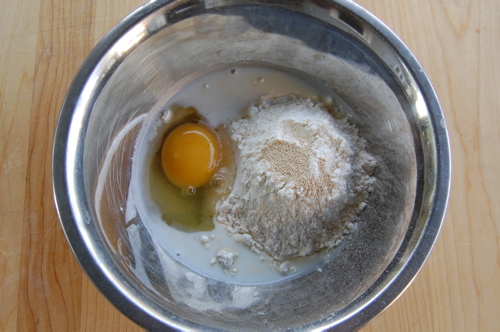
Stir all of it together withe a fork until the mixture is the consistency of a thick batter.

This is your sponge. Use it right away or, for best flavor, make it a day ahead of time, let it ferment for an hour at room temperature then refrigerate it overnight. When you’re ready to prepare your dough scrape it into the bowl of an electric mixer.
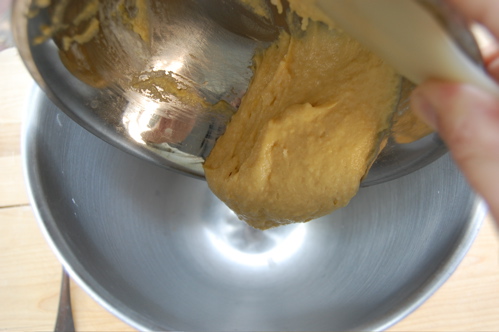
Then whisk together a mixture of:
6 ounces all-purpose flour
2 tablespoons sugar
1 1/4 teaspoons instant yeast
1/2 teaspoon salt
Like so:
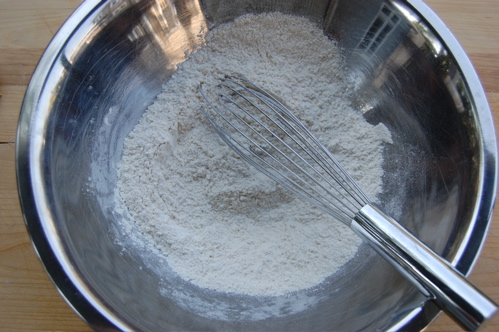
…and sprinkle over the sponge in the mixer bowl.

Let it sit for 2 hours, 2 1/2 – 3 if the sponge was refrigerated. The dome of dry mix will crack as the sponge expands. It may even bubble through in a few spots. This is good.

To mix, add two cold eggs and using the dough hook, beat the mixture for 2-3 minutes on medium speed.

When it gets to looking like so…

…start adding your butter. With the machine running, begin to add 4 ounces of very soft butter. If you want the brioche to rise high, say for a large brioche loaf, go a little lighter, maybe 2 1/2 ounces. If you’re making something rich like cinnamon rolls, the full four ounces work great. For maximum flavor use an ounce or two of browned butter. Add it a tablespoon at a time, letting the dough absorb each addition before adding another, about two minutes of mixing per tablespoon of butter.
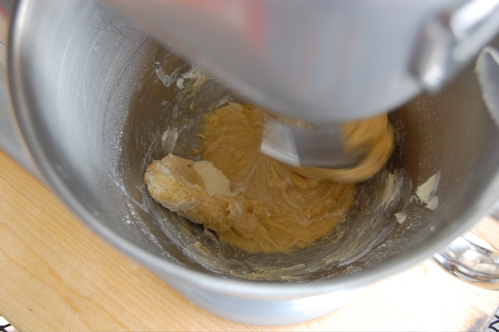
Notice how light and sticky the dough gets. This is a terrific consistency for something like cinnamon rolls or têtes-de-brioche. Again if you want a higher-rising brioche, keep kneading the dough for another ten minutes or so to develop more structure (gluten).
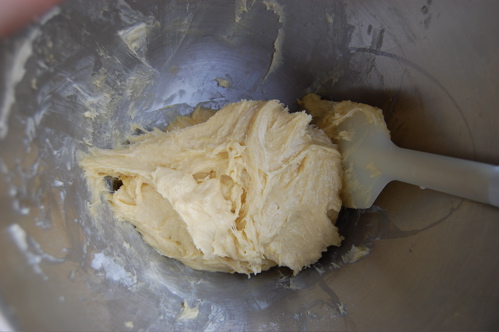
Once the dough is uniform (and it might take an extra bowl scraping or two), scrape it into a oiled bowl or rising container.

Let it rise another 1 1/2 hours until it looks about like so:

Drape a piece of plastic wrap over it and deflate it by gently pressing down on it with your hand.

Put it into the refrigerator, letting it chill for a minimum of two hours, preferably overnight, to firm it (you’ll likely need to deflate it one more time after the first hour or so). For maximum flavor let it ripen for up to three days in the fridge. It can be frozen for several months.
Hello Joe:
Thanks for the great tips and recipies! Can the Brioche Dough be shaped and then frozen. I have to make several smal brioche for a wedding (at which I am also a guest, and therefor busy that day) and it would be great if I could make them, proof them, shape them and freeze. Is that doable?
Thanks
Ben
Joe
How come no bread flour was used in this recipe.
Hi June!
I don’t use bread flour because I’m content with the rise with this brioche, and I especially like the texture. Bread flour is sometimes used because the extra gluten helps create a rising network despite all the fat. Me, I don’t think it’s necessary. However if you want a higher rising brioche, and don’t mind the slightly tougher character of the finished bread, you can add some in!
– Joe
Hi Joe
I made cinnamon rolls using Brioche dough, and it was a great success, why do bakeries use danish pastry to make cinnamon rolls, after making my batch with brioche dough I know the difference….thanks a million.
My only problem is the dough warms up pretty quickly..I guess living in the Caribbean has its advantages as well as disadvantages.
Hey June!
Great to hear things went so well (save for the climate variation)! I think the reason is partly the expense and partly the trouble. Brioche is quite buttery, and a “sweet yeast dough”, a non-laminated dough often used for Danishes, is frequently used for cinnamon rolls. It all depends on what the processes of the bakery are. Some bakeries laminate dough, others don’t. Some make brioche, other don’t. Base materials tend to get used for many different things, depending on what’s around.
– J
Hi Joe!
I’d like to substitute active dry yeast for the instant yeast called for in the recipe. Is there anything else I’ll need to change to make it work?
Hi Ally!
Active dry is harder to work with in this context. But try warming the milk a little first, then combining it with the yeast. That should wake it up a bit and get it going. As for the second addition, just use it as you would the instant, though I think it will take longer to get going. Best of luck with it!
– Joe
I don’t have a mixer, or anything like that. Any tips on kneading the butter into a sticky dough like this by hand?
Hi Zach! Use a big wooden spoon and a tall (versus narrow) bowl. You don’t want to touch this dough by hand since the butter will liquefy. Just be prepared for a workout! Let me know how it goes!
– Joe
Hi Joe,
Apologies if I missed it, but how much butter goes into these for the last step?
nevermind i see it!
Sorry for any confusion, Jake.
– Joe
Hi Joe,
I love your website. The clarity of the instructions, the spot-on no-nonsense photos, the helpful suggestions on spreading a project over a few days or invaluable reminders to first gather all the ingredients, and the occasional insightful scientific asides on methods and ingredients. And your sense of humor and writing style. This is a great website, really 🙂
I had a couple of specific questions about the brioche dough recipe. After I take the dough out of the refrigerator, are there recipes where I would want to give it some time to come to room temp (and how long?) before shaping, or would I always proceed straight to shaping? Like for brioche à tête, or bienenstich? If the dough has been frozen, do I defrost it in the fridge first, or let it sit a bit on the counter?
Also, I heard in a baking class once that only yeasted dough made with fresh yeast will survive freezing, as the fresh yeast tolerates a wider range of temperatures than dry east, and that it is for this reason that wholesale operations producing thousands of frozen croissants to be baked at smaller cafes and restaurants later on use only fresh yeast. Is that not correct? Partially correct?
Many thanks!
Hey Lyd!
You sure made my day! Thanks for all the generous comments!
Regarding brioche, while you can let it warm it’s much easier to shape when it’s chilled. As the butter in it softens it gets very sticky and hard to shape, so I generally always prefer to work with it when it’s cold.
Regarding the fresh yeast, what you heard was not true. There’s very little practical difference between compressed yeast and dehydrated instant yeast, especially once it’s been incorporated into a dough and allowed to grow. After rising there’s no difference at all between fresh and instant or active dry…it’s all the same culture of fungus, none any more resilient than any another. That’s why I generally prefer instant…it keeps beautifully in the freezer before use, is easy to incorporate, gives a strong rise and, if necessary, freezes very well before baking. It’s my go-to yeast.
Cheers and thanks again!
– Joe
Hi Joe,
It is realy a big treasure trove that i find this great site .. your site realy is great
My question regarding brioche dough, does it matter if the butter is melted “in fluid state” rather than being very soft as i don’t have a machine and will mix manually
Also why you use yeast and not baking powder in this dough “when making kugelhopf” while the kugelhopf seems like traditional cake
More clearly what is the main difference between the baking powder and yeast when baking sweet pastries?
Sorry for my basic questions as i still beginner baker
Best Regards,
Hello Hassan!
I am very pleased to answer basic questions!
If the butter is very soft (almost melted) it will actually be easier to knead it into the dough. The liquid butter will be much harder to work with since it will run out of the dough. Still if you would rather use melted butter it shouldn’t be a problem.
Regarding your other question, yeast is used for brioche because it is a bread — a very rich bread — but still a bread (even though it is sometimes used for sweet things which we still call “cakes”). For that reason yeast does a very good job of raising it. Baking powder is more useful in American-style cakes where the layers must be very thick but also very tender and crumbly. It creates a very different texture compared to yeast, soft instead of firm.
Does that make sense?
Cheers,
– Joe
I love the idea of the addition of brown butter! Question — are the additional 1-2 oz of brown butter in addition to the 4 oz, or as a substitute for two of those ounces?
Many thanks….